about me

Erik Smithson
March 2nd Year
About me: I am an avid designer who is currently finishing my last year of M.arch. I enjoy soccer (football), the ocean and discovering things. Generator: The name of the blog is its intention. I want to use this blog as a place filled with useful information to generate ideas.
Questions? Or just want to chat? Contact him on z3158835@student.unsw.edu.au
12:01 AM | Wednesday, April 29, 2009
Public Transport vs Private Car Ownership
Check out the Then & Now Gallery
Interesting how the connection between people and the street has changed over time.
The early days technology afforded slower moving transport - old cars, horse & cart, trams. The city was small enough to do most traveling by foot, aided by trams. The 'walking city' allowed movement to become free and uninhibited by roads.


The introduction of both train and automobile caused the birth of the 'commuter city'. This city is the sprawled Sydney that encloses the historic, smaller inner-city. The roads are now only for cars and pedestrians are now limited to footpaths. Arcades and thoroughfares through buildings connect roads with pedestrian walkways, exposed to retail shopping environments. It is encouraged by the City of Sydney council that high-rise development can gain extra FSR by providing its ground floor with public space for walking. This is a good adaptation to a city divided by gridded barriers.
Limiting the 'Commuter City'
Lets compare Sydney to Singapore.
Singapore is 710km2 with 4,839,400 people and density of 6,814people/km2.
Sydney is 12144km2 with 4,336,374 people and density of 2058/km².
Just look at the difference in density and area. The distance to commute to the inner-city areas is far larger on Sydney and the transportation system needs to move large amounts of people over large distances. Singapore, requires large amounts of people over smaller distances. Their MRT train system as well as the public bus transportation system is relied upon by the majority of commuters (about 4.2mill daily uses). Private vehicle ownership is heavily taxed and quotas are imposed on vehicle purchase. Then there are the high tolls imposed on private vehicles who wish to drive into Central Area during high traffic times.
Such measures in a city like Sydney, like tolls into the inner city have been put into practice. But taxing private cars is not an option with a city of such land mass. Thus the real question is: how can public transport be effective enough to turn commuters away from private vehicle usage whose roads, motorways has clearly fragmented the inner city?
0 Comments:
10:41 PM | Saturday, April 4, 2009
Case Study: Kyoto Train Station Building P.I
Timeline of Kyoto Station:
1877: First train station opened by decree by the Emperor Meiji.
1914-1950: Replaced by station of westernised architecture and burned down.
1952: Utilitarian concrete station is built.
1997: Kyoto Train Station Building designed by Hiroshi Hara was built.
The timeline shows the evolution of a station that maintained a similar small scale (as compared to the surrounding prefectory) and suddenly replaced by one of the largest station buildings in the world. The presentation of this case-study brings to question the efficacy of train station development on a massive scale in order to revive a city.
Presenting:
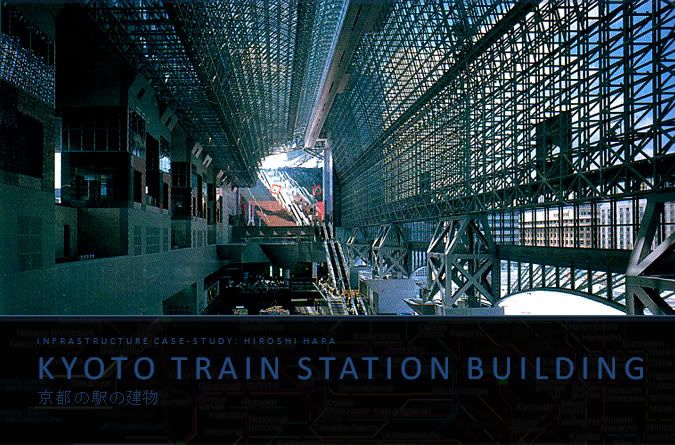
The following table shows the differences between Kyoto Prefectory and Sydney. The following graphs show the percentage of transportation usage per city (Sydney top, Kyoto bottom):
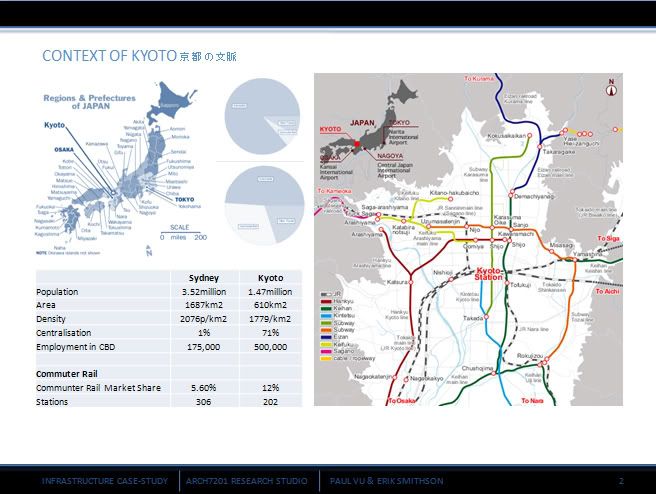
For Kyoto Train Station, a larger percentage of money is invested into commuter rail (as well as into other infrastructure) and therefore has resulted in an efficient transportation system. This has further resulted in more people in Kyoto relying on this kind of transport to get around. I think this is as much as we predicted.
In Sydney, less funding has resulted in less reliance on this transportation. But it is dangerous to take this postion as the city of Sydney was created mainly for the automobile and the urban sprawl along with smaller population has lead to the public transport system to be stretched. This is shown also with the 1% of people in Sydney occupying high density areas, namely the Sydney CBD.

HOW BIG IS THIS BUILDING? When Paul and I first looked at this building it was only of interiors and we actually found it to be quite amazing. It's exterior is a different story: it really reflect the American Mall, suburban shopping centre of a controlled interior environment to indulge newcomers to consume, attracted by the magnificent roof and stairways, laden with artwork. Programmatically, it is an attempt to introduce plenty of public space, allowing for the building to become a civic centre for the city. In fact, it automatically becomes a gateway to Kyoto in that you must move through the building on arrival by train.
The architect, Hiroshi Hari, has commented many times that he feels the building is far to bulky than he intended for it but it was out of his power to change the course of the design process. Nice excuse buddy.

Despite the overwhelming size of the building, the connection to context is interesting when viewed in terms of the building's artificial topography consisting of a valley and the flat landscape of Kyoto around. There is the movement up and down the building on an east-west axis and then smaller 'off-ramps' are provided from the main walkway to access the various programmes ie: convention centre, hotel, retail store etc.

Not only is Kyoto Train Station Building a civic hub for the city, it also serves as one of the major infrastructure hub's in Japan. The station mixing modes of transport to allow for changes in between.
0 Comments:
4:26 AM | Wednesday, April 1, 2009
Structural Growth II
For the final, Paul and I decided that we were going to create an exciting pattern on the cardboard because we thought it could be used as a foundation for our structure.

Getting it cut took an hour:
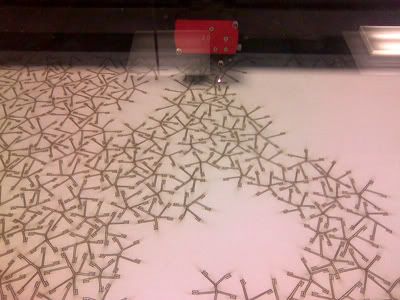


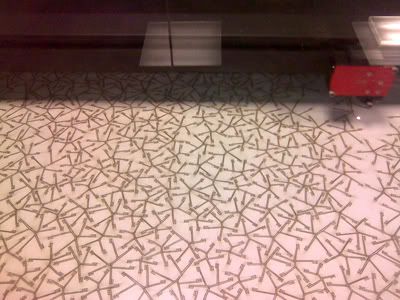
Camera phone ftw^
Statement: This project has highlighted the potential of two simple shapes that can be rotated and fitted together to form a complex, irregular 3D form. These two shapes take on the role of ‘branches’ that extrude outwardly with potential for other shapes to connect to each end. The shapes are highly flexible in the way they can be rotated in six ways and still able to join to adjacent shapes without changes to the three dimensional shape.

Concept: Branches connect and grow outward and upward. The dense inter-weaved sphere bursts forth from its rigid, two dimensional roots into three dimensional freedom. Folded planes, the remnants of the two dimensional plane, sprawls outwards into fragments. The loss of branches, resembling cracked soil following drought, contributes to a growing structure. To prevent the sphere from falling, an outer structure holds the sphere in place.

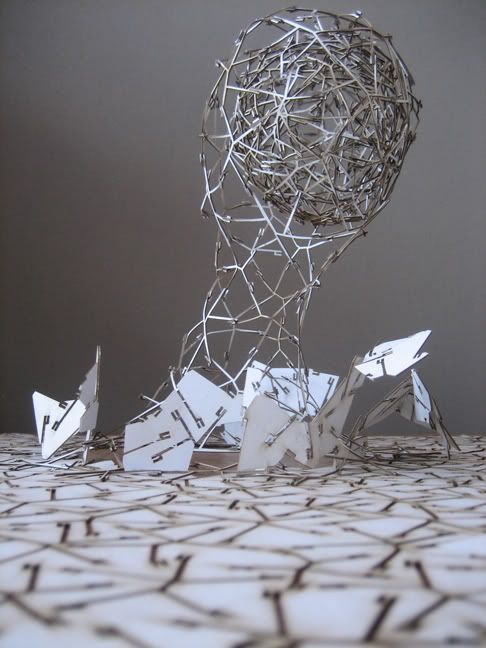
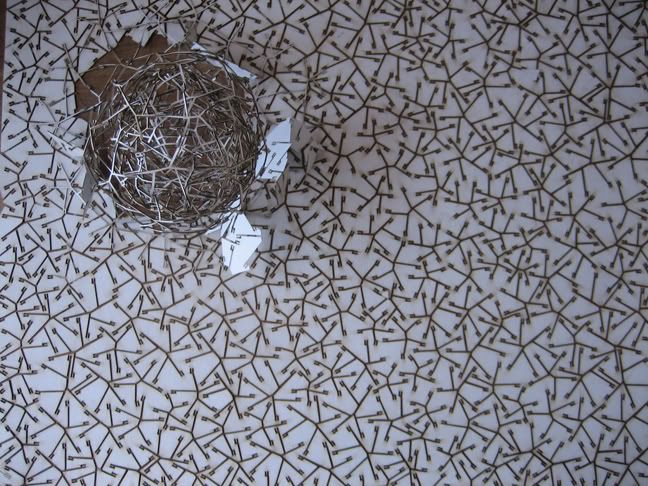

That's the end of the story.
Kinda looks like the world cup :/
1 Comments:
heloooo
By  Unknown, at
April 1, 2009 at 5:24 AM
Unknown, at
April 1, 2009 at 5:24 AM
4:20 AM |
Structural Growth I
Project Name: Laser Cutting Exercise
Group Members Involved: Erik Smithson and Paul Vu
Requirements: a sheet of cardboard, a 60grand laser cutter and some imagination.
Point: To understand how to use the laser cutter and to have some fun!
The initial idea was to create three spheres of different densities that when inside each other creates an interesting layering effect.
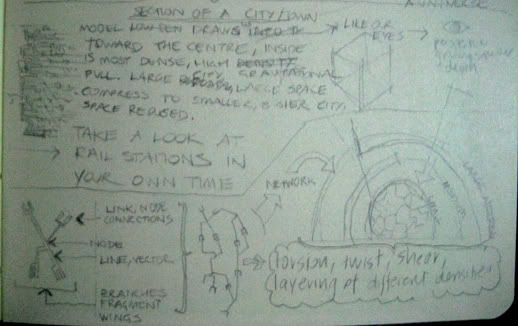
The next step was to then create these shapes on illustrator to define the shapes to cut out (requires vector lines for precision). The small shapes are about five cm by 2cm (you can imagine the precision of the laser):

We had them cut and took about 12min. The rigid shapes were assembled without glue and the structure was quite strong. It is also very interesting in the way these regular geometries ended up forming into such an organic shape:
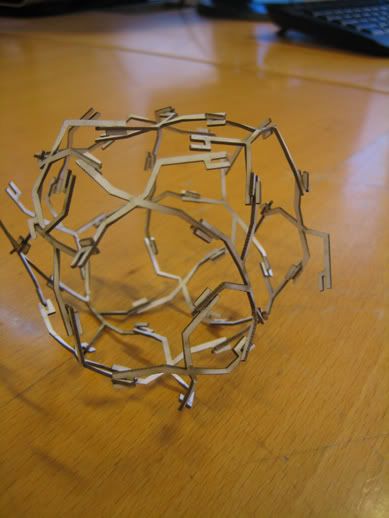



Above: We had large, medium and small sized pieces to create three attempts at spheres, fitting one in the other.
0 Comments:
3:50 AM |
Generator
Welcome to the GENERATOR.
The name is its purpose: I wish to use this blog as a container of information that can help generate ideas. This information can then be processed through interrogation. This will allow me to understand more on my subject matter.

